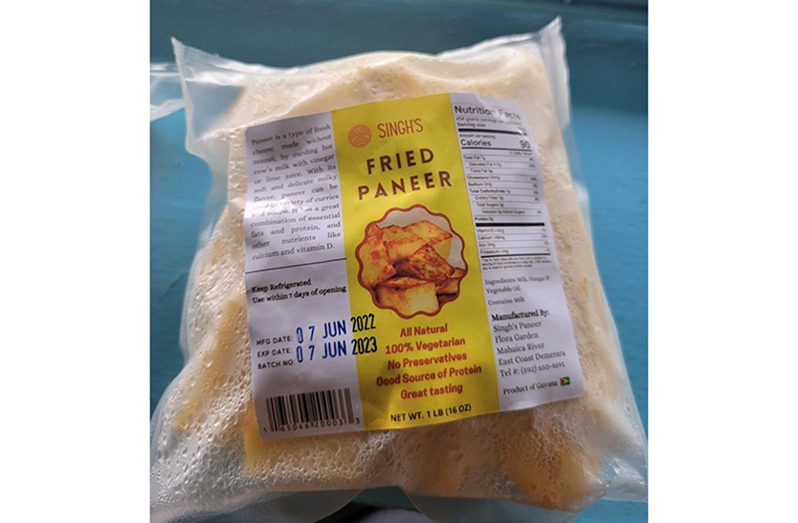Local farmer’s product is among one of the best sellers in leading supermarkets countrywide
MOHAN Singh from Flora Garden, Mahaica Creek, is a paneer-maker of fried and regular paneer, which he supplies to most leading supermarkets across the country. He is also a cattle and poultry farmer with a thriving small business from his home.
Singh is a down-to-earth kind of man who had a vision to expand his small business, which started by making paneer for home use, and then he began making even more due to the demand for the product.
The 51-year-old told the Pepperpot Magazine that Singh’s Farm “Grow with us, Eat with Us” has layer eggs, fried paneer, and regular paneer.
Singh’s farm is located at Flora Garden, Mahaica Creek, and can be accessed via De Hoop Branch Road, Mahaica.
He has about 95 cows, and more than 200 layer birds, and collects his own eggs and fresh cow’s milk daily.

Singh is the father of two, and he, his wife and children manage the farm and the paneer-making small business.
He is a local from the riverine community, and has no intention of relocating, since he earns from his farm/home.
Paneer is a fresh acid-set cheese common in the cuisine of the Indian subcontinent, and is made from full-fat buffalo milk or cow milk. It is a non-aged, non-melting soft cheese made by curdling milk with a fruit- or vegetable-derived acid, such as lemon juice or vinegar.
Both fried and regular paneer can be used for curries or general cooking, and it is available in most supermarkets at a retail price of $1,200 per pack.
Singh explained that paneer-making is a long process involving tedious planning and preparation for it to succeed.
He reported that when he started, he needed guidance, and approached the Ministry of Agriculture.
Singh, via the Guyana Marketing Corporation (GMC), received the assistance he needed to get registered, licensed, labelled, packaged and compliant with the relevant authorities for a high-quality product of a particular standard which is wholesome.
He told the Pepperpot Magazine that he uses fresh cow’s milk from his own farm, and would also buy from local farmers in the community.
Singh disclosed that from his own daily take of fresh cow’s milk, he decided to make paneer for his own home use. Then, people began asking for a bit more, and he decided to make more, based on demand.

He related that his small business began making a larger batch of regular and fried paneer, and after he received the necessary standards such as package, label and licence his business took off.
Singh added that the GMC assisted him in marketing his home-made product, and he makes a batch from 25 gallons of fresh cow’s milk weekly for distribution to supermarkets.
He reported that he would do his distribution on Thursdays weekly, and his small business has been in operation for the past two years.
The farmer related that before he started his small business of paneer-making, he used to get a lot of milk, since the customers who once bought could no longer do so.
And before it went to waste, he decided to make use of it by making paneer for his own kitchen, and then it turned into his small business from which he and his family earn today.
Singh explained that he cannot afford to employ people, so he, his wife, daughter and son collectively manage everything from their home, and so far, it is going well.
“I never imagined that my simple home-made recipe of paneer would be on the shelves of more than 15 leading supermarkets in the country and as far as Essequibo, and I am happy that it turned into a small business from which I can earn with support from my family and the Ministry of Agriculture, it was possible,” he said.
Singh disclosed that so far, he has had good feedback on his product, and maintains that his paneer is of excellent quality, hygienic and has met all of the required standards.
The local farmer added that from his layer birds farm, he would collect 200 trays of eggs daily, and although it is a lot of work, he manages with the help of his wife and two children.
Singh stated that when the area was flooded, he managed to take his cows to higher ground, and that’s how he kept his cattle alive, and was able to recover and restart his farm following the devastating natural disaster that struck more than once.












